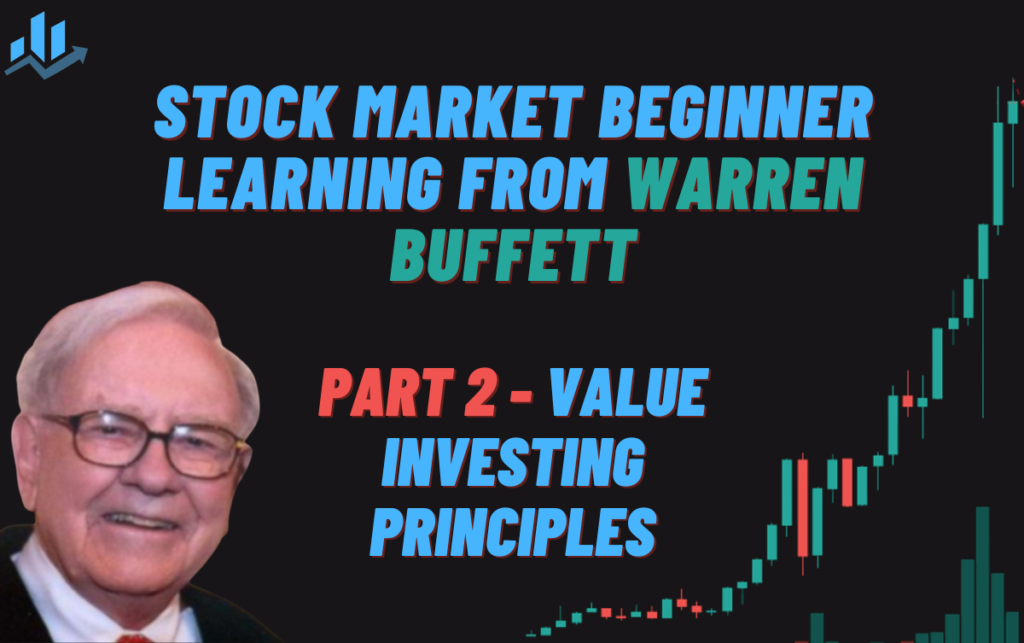
Welcome to Part 2 of our blog series, “Stock Market Beginner Learning from Warren Buffett.” In our previous post, we explored the importance of patience in the stock market and how it can lead to successful investing. Today, we delve into another crucial aspect of Warren Buffett’s investment philosophy: value investing.
Learning from the Oracle of Omaha is invaluable for stock market beginners. Warren Buffett, one of the most successful investors of all time, has built his fortune through a disciplined and rational approach to investing. At the core of his strategy is the concept of value investing.
Value investing emphasizes the importance of determining the intrinsic value of a stock and buying it at a price that provides a margin of safety. Two key quotes from Warren Buffett encapsulate the essence of value investing: “Price is what you pay. Value is what you get” and “It’s far better to buy a wonderful company at a fair price than a fair company at a wonderful price.”
Understanding these quotes is fundamental to grasping the significance of value investing in Warren Buffett’s approach. In the following sections, we will explore the concept of value investing, its principles, and how it has contributed to Warren Buffett’s remarkable success. Get ready to learn valuable insights that will empower you as a stock market beginner.
Table of Contents
Toggle1. What is Value Investing?
Value investing is an investment strategy that involves identifying and purchasing stocks that are believed to be undervalued by the market. The fundamental principle of value investing is based on the idea that the price of a stock may not always reflect its true worth or intrinsic value. Value investors seek to capitalize on this discrepancy by buying stocks at a price lower than their intrinsic value, thus providing a margin of safety.
Value investors employ various methods to identify undervalued stocks. They analyze a company’s financial statements, including its balance sheet, income statement, and cash flow statement, to assess its intrinsic value. By examining factors such as earnings, assets, and growth potential, value investors aim to determine the true value of a company and whether its stock is priced below that value.
A distinguishing characteristic of value investing is its focus on long-term value creation rather than short-term market fluctuations. Value investors have a patient and disciplined approach, willing to hold onto their investments for an extended period. They believe that over time, the market will recognize and reflect the true value of the stocks they hold, leading to favorable returns.
2. Understanding the Quotes:

“Price is what you pay. Value is what you get,”
The first quote, “Price is what you pay. Value is what you get,” emphasizes the importance of assessing the intrinsic value of a stock. It highlights the notion that the price paid for a stock is not necessarily indicative of its actual value. Value investors conduct thorough analysis to determine the intrinsic value of a stock, considering factors such as the company’s financial health, competitive advantages, and growth prospects. By focusing on value rather than price alone, investors can make informed decisions that align with their long-term investment goals.
Paying the right price relative to the underlying value is essential for favorable investment outcomes. When a stock is undervalued, purchasing it at a price below its intrinsic value provides a margin of safety. This margin of safety acts as a cushion against potential market downturns and increases the likelihood of generating positive returns in the future.

“It’s far better to buy a wonderful company at a fair price than a fair company at a wonderful price,”
The second quote, “It’s far better to buy a wonderful company at a fair price than a fair company at a wonderful price,” underscores the significance of investing in high-quality companies with competitive advantages. A wonderful company refers to a company with strong financials, a sustainable business model, and a durable competitive position.
Warren Buffett advocates investing in such companies even if the price is fair, rather than settling for a mediocre company at a bargain price. The emphasis is on the long-term value and potential growth of the company, rather than seeking short-term gains from undervalued but inferior businesses.
By following these principles of value investing, stock market beginners can develop a disciplined and rational approach to investing, focusing on the underlying value of a stock rather than short-term price fluctuations. This strategy provides a solid foundation for building a successful investment portfolio over time.
3. Warren Buffett’s Value Investing Strategy:
Warren Buffett, often referred to as the Oracle of Omaha, is renowned for his successful value investing strategy. His investment philosophy aligns closely with the principles of value investing, making him an influential figure for stock market beginners to learn from.
Key Factors
One of the key factors in Buffett’s evaluation of potential investments is the company’s competitive advantage or economic moat. He seeks businesses with durable competitive advantages, such as strong brands, high entry barriers, or unique products/services. These advantages provide a higher probability of sustained profitability and long-term value creation.
Financial Health
Buffett also emphasizes the importance of assessing a company’s financial health. He looks for companies with consistent and growing earnings, strong cash flows, and a solid balance sheet. By focusing on financially stable companies, Buffett reduces the risk of investing in businesses that may face financial difficulties in the future.
Management Quality
Another crucial aspect of Buffett’s value investing strategy is his emphasis on management quality. He looks for companies with competent and shareholder-friendly management teams who prioritize the long-term interests of the company and its investors. Buffett believes that trustworthy and capable management plays a significant role in the success of a company.
Notable examples of successful value investments made by Warren Buffett include his holdings in companies like Coca-Cola, American Express, and Apple. In each case, Buffett recognized the intrinsic value and long-term potential of these companies when their stocks were undervalued. He patiently held onto these investments, allowing them to grow and deliver substantial returns over time.
Buffett’s value investing strategy has consistently delivered impressive results, and his track record speaks for itself. By focusing on strong companies with competitive advantages, sound financials, and exceptional management, Buffett has built a remarkable investment portfolio.
As stock market beginners, understanding and applying Warren Buffett’s value investing principles can provide a solid framework for identifying potential investment opportunities and making informed decisions. By studying Buffett’s successful value investments, beginners can gain valuable insights into the characteristics of attractive investment prospects and the importance of patience and a long-term perspective in achieving investment success.
4. Fundamental Analysis and Value Investing:
Fundamental analysis plays a vital role in value investing, helping stock market beginners assess the intrinsic value of a company and make informed investment decisions. By examining a company’s financials and other relevant factors, fundamental analysis provides insights into its true worth and potential for long-term value creation.
When conducting fundamental analysis, several key financial metrics and indicators are used to assess a company’s value:
Earnings Per Share (EPS):
EPS measures a company’s profitability by dividing its net income by the number of outstanding shares. Increasing EPS over time indicates growing profitability, which is an essential factor in value investing.
Price-to-Earnings (P/E) Ratio:
The P/E ratio compares a company’s stock price to its earnings per share. A low P/E ratio relative to industry peers may suggest an undervalued stock. However, it is crucial to consider other factors alongside the P/E ratio to gain a comprehensive understanding of a company’s value.
Price-to-Book (P/B) Ratio:
The P/B ratio compares a company’s stock price to its book value per share. A lower P/B ratio can indicate an undervalued stock, but it is essential to assess other factors and industry norms to make an informed judgment.
Dividend Yield:
Dividend yield represents the annual dividend payment as a percentage of the stock price. For value investors seeking income and stability, a higher dividend yield can be attractive. However, it is crucial to consider the company’s financial health and dividend sustainability.
Debt-to-Equity Ratio:
This ratio compares a company’s total debt to its shareholders’ equity. A lower debt-to-equity ratio generally indicates a healthier financial position. Value investors prefer companies with manageable debt levels, as excessive debt can pose risks to long-term stability.
For stock market beginners conducting fundamental analysis, here are some practical tips:
Study the company’s financial statements, including the balance sheet, income statement, and cash flow statement, to understand its financial health, revenue growth, and cash flow generation.
Research the company’s industry and competitive landscape to assess its competitive advantages, market position, and potential for long-term growth.
Analyze the company’s management team, their track record, and their strategic vision for the company’s future.
Stay updated on relevant news and events that may impact the company, such as industry trends, regulatory changes, and competitive developments.
Seek guidance from reputable sources, financial experts, and investment professionals to enhance your understanding of fundamental analysis and value investing.
By incorporating fundamental analysis into their investment process, stock market beginners can make more informed decisions, identify undervalued stocks, and build a portfolio with long-term growth potential. Remember, fundamental analysis is a continuous learning process, and it is essential to refine your skills and stay updated as you gain experience in the stock market.
5. Margin of Safety:
In value investing, the concept of a margin of safety is of utmost importance, particularly for stock market beginners. It refers to the practice of buying a stock at a price significantly below its intrinsic value, providing a cushion or margin of safety against potential losses and uncertainties.
The margin of safety acts as a protective buffer, safeguarding investors from unfavorable market conditions, unforeseen events, or potential miscalculations in estimating a company’s intrinsic value. By purchasing a stock at a significant discount to its intrinsic value, investors create a margin that mitigates the risk of capital loss and increases the potential for favorable investment outcomes.
Determining an appropriate margin of safety involves careful analysis and consideration of various factors. Here are a few examples and strategies to help stock market beginners assess the margin of safety:
Intrinsic Value Assessment:
Conduct a thorough analysis of the company’s financials, competitive position, and growth prospects to estimate its intrinsic value. Consider multiple valuation methods, such as discounted cash flow (DCF) analysis or comparative valuation approaches, to derive a range of intrinsic values. The larger the discrepancy between the estimated intrinsic value and the market price, the greater the margin of safety.
Considering Uncertainties:
Acknowledge and account for uncertainties and potential risks associated with the company, its industry, or the broader market. Assess factors such as regulatory changes, technological advancements, competitive threats, or economic conditions that may impact the company’s future performance. A wider margin of safety is warranted when uncertainties are higher.
Conservative Assumptions:
Adopt a conservative approach when estimating future earnings, growth rates, or cash flows. By erring on the side of caution and using conservative assumptions, you create a larger margin of safety. This approach guards against overly optimistic projections and allows for unforeseen challenges or setbacks.
Comparative Analysis:
Compare the current market valuation of the company to its historical valuation levels, industry peers, or market benchmarks. If the stock appears undervalued relative to historical averages or similar companies, it may indicate a potential margin of safety.
Diversification:
Build a diversified portfolio of stocks across different industries and sectors. This strategy spreads the risk and reduces the impact of individual stock price fluctuations. Diversification itself provides a margin of safety at the portfolio level.
Remember, the margin of safety is not a precise figure but rather a concept that promotes prudence and risk management in investing. It varies depending on individual risk tolerance, investment goals, and the specific characteristics of the company being evaluated.
By incorporating a margin of safety into their investment approach, stock market beginners can protect themselves against downside risks, increase the likelihood of favorable returns, and develop a disciplined and patient mindset in value investing.
6. Conclusion:
In this post, we explored the principles of value investing, which are crucial for stock market beginners to grasp. We discussed the concept of value investing, emphasizing the importance of understanding the intrinsic value of a stock rather than solely focusing on its market price. By assessing the intrinsic value, investors can determine whether a stock is undervalued and has the potential for long-term growth.
We delved into two key quotes by Warren Buffett: “Price is what you pay. Value is what you get” and “It’s far better to buy a wonderful company at a fair price than a fair company at a wonderful price.” These quotes underscore the significance of evaluating a company’s true value and investing in high-quality companies with competitive advantages.
Furthermore, we explored Warren Buffett’s investment strategy and how it aligns with value investing principles. His emphasis on factors such as a company’s competitive position, long-term growth prospects, and prudent investment decisions serves as a valuable guide for stock market beginners.
As we conclude this post, it is crucial for beginners to recognize that understanding the intrinsic value of a stock forms the foundation of value investing. By conducting thorough fundamental analysis, considering a margin of safety, and adopting a long-term perspective, investors can navigate the stock market with greater confidence.
In our next post, get ready to dive into the captivating world of Investor Temperament and Contrarian Thinking. Discover why having the right mindset and emotional discipline is vital for investment success. Join us for an enlightening discussion that will empower you as a discerning investor. Stay tuned for valuable insights to enhance your investment approach.